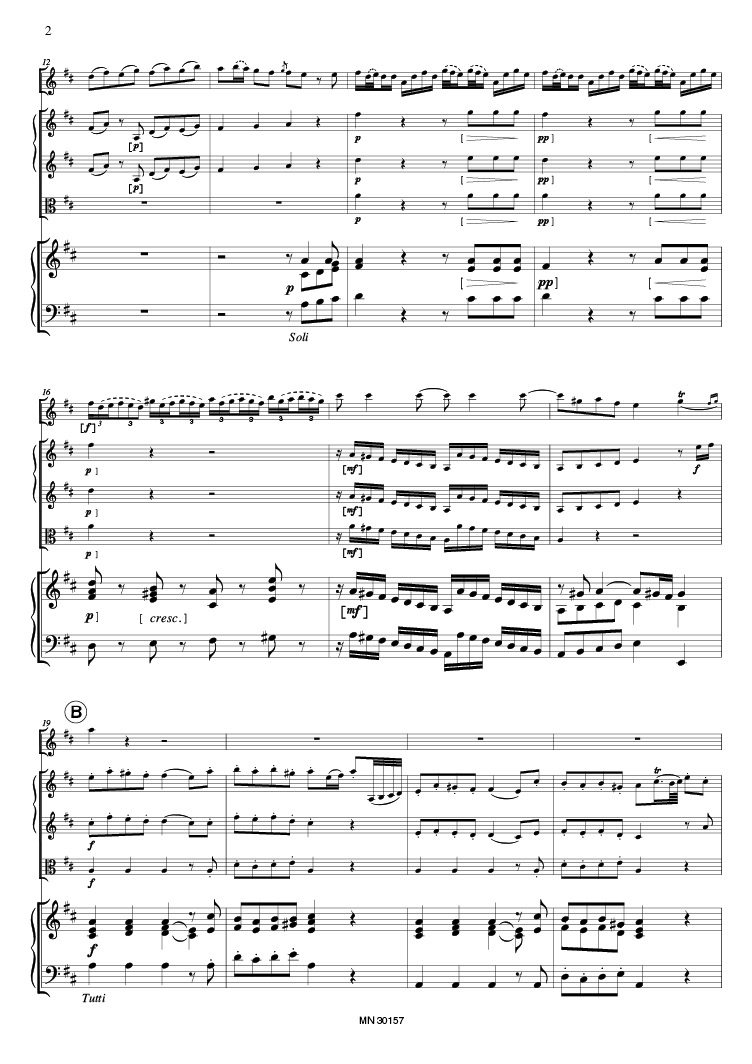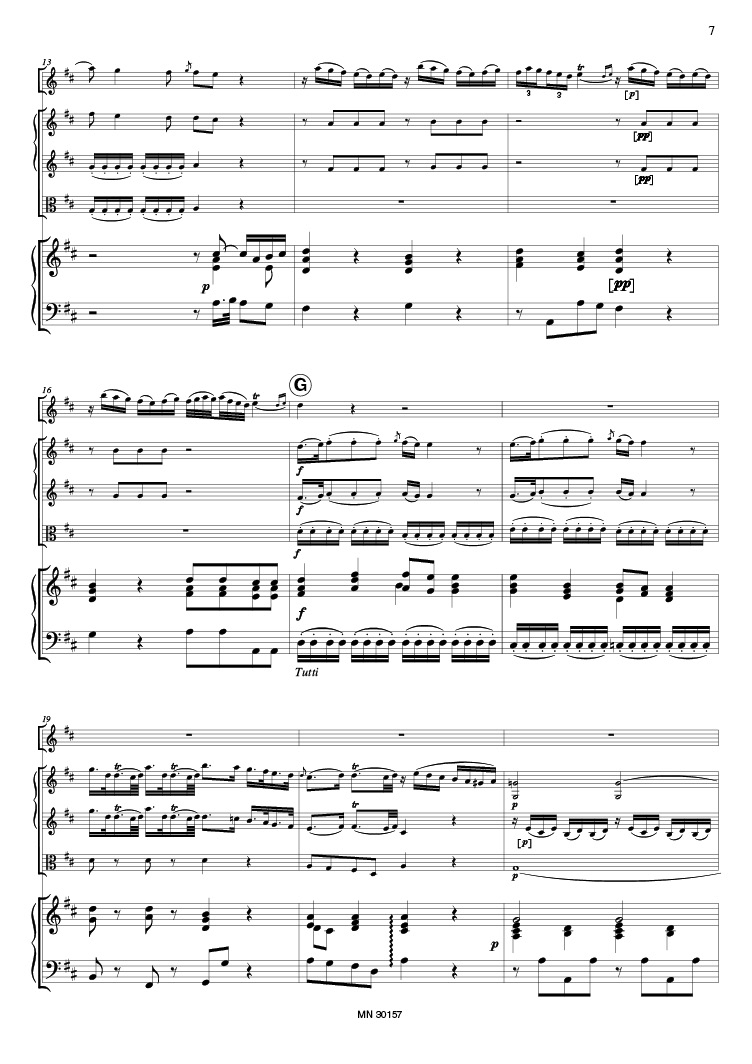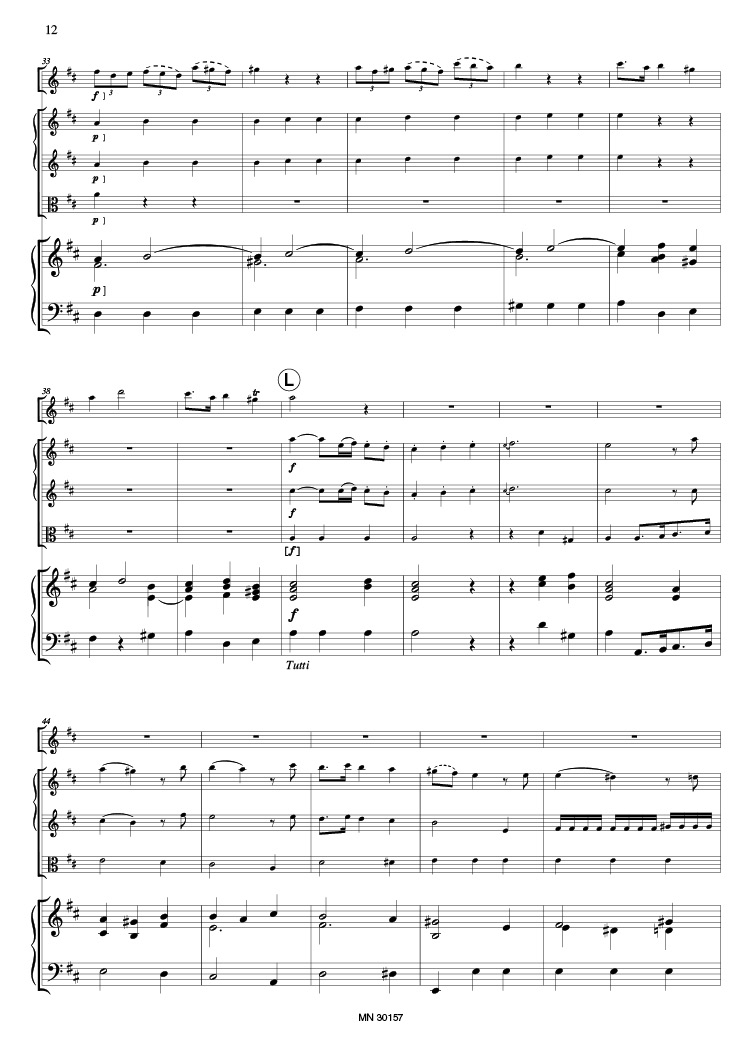
Hertel Concerto per la Tromba No. 3 in D
Instrumentation: Trumpet, Strings, Basso continuoDifficulty (I-VI): V
Parts for:
MN 30157: Trumpet in D, High A, Strings 4324, B. c., Score
MN 30158: Trumpet and Keyboard
Series: Edward Tarr Brass
Editor: Edward H. Tarr
Johann Wilhelm Hertel was born on October 9, 1727 in Eisenach and died on June 14, 1789 in Schwerin - as the gentle reader will have recognized, he died a month to the day before the outbreak of the French Revolution. His father Johann Christian Hertel (1699-1754) was a well known player of the viola da gamba and the violin as well as a composer, and was active in Eisenach and Strelitz (Mecklenburg). His grandfather Jakob Christian Hertel (fl c. 1667 - c. 1726) was once a chapelmaster (Kapellmeister) in Oettingen and Merseburg. He received his early musical training from S. L. Heil (1706-64), a pupil of J. S. Bach. By the age of 12 he was good enough to accompany his father on the harpsichord during concert tours. He studied the violin in 1742-43 with Carl Köckh in Zerbst and later with Franz Benda(1709-86) in Potsdam.In 1744 he was appointed violinist and harpsichordist at the court of Strelitz, where his father had been working since 1741. When this court was dissolved in 1753 and his father was pensioned off, he moved to Schwerin, where he held the position of court composer. In 1765 he received the additional appointment as private secretary to Princess Ulrike. When the court orchestra was moved to Ludwigslust two years later, Duke Ludwig graciously allowed his dismissal, so that he could remain in Schwerin. From 1770 he was privy councillor in the service of the Princess, a position which nevertheless did not hinder him from continuing to compose and to arrange concerts. In his late years he abandoned the violin in favor of keyboard instruments.
Today, Hertel's music seems to be undergoing a modest rediscovery. In the 1960s, Walter Hermann Sallagar edited a so-called concerto of his in D major for trumpet, 2 oboes, and 2 bassoons, as well as certain other works involving bassoon. Edward Tarr brought out Hertel's Double Concerto in E flat for trumpet and oboe and made the first recording of it in 1965; shortly afterwards he published the Trumpet Concertos No. 1 and No. 2, both in E flat major. With the present edition of the third and last one in D major the publication of Hertel's works for solo trumpet is now completed.
The Trumpet Concerto No. 3
This work was without a doubt composed during Hertel's tenure in Schwerin. Reine Dahlqvist estimates on stylistic grounds that it was composed around 1760. Like his works in general and his Trumpet Concerto No. 2 in particular, this concerto possesses a very clear form. Hertel's individual movements are usually in three parts a first section at the tonic, preceded by a long multi-partite orchestral introduction; a second one at the dominant, preceded by a somewhat shorter orchestral introduction, also at the dominant; and a third section at the tonic, the orchestral introduction of which is still more compact. The last, cadenza-like trumpet flourish brings in an orchestral conclusion taken from the opening material. All three movements of the Concerto No. 3 are faithful to this scheme, whereby the middle movement is in B minor with a middle section in D rather than the dominant. B minor was at least theoretically an "impossible" key for the natural trumpet, since the tonic is not present in the 3rd octave of the harmonic series and in the upper octave (13th partial, b") is too flat. Again and again in the course of the Baroque trumpet's glorious history we find composers who tried to escape the ubiquitous D major straightjacket by coaxing delicate minor modes from this heroic instrument. In the 17th century, for example, it was H. 1. F. Biber (Sonata X a 5 and duets nos. 11 and 12 from Sonatae tam aris quam aulis servientes, 1676) and P. J. Vejvanovsky (c. 1640-93, Sonata a 4 Be mollis) in Bohemia and P. Franceschini (Sonata a 7 con due Trombe, 1680) in Bologna who wrote long passages or even entire works in the minor mode. Even Bach and Handel tried their hand at this kind of composition. Handel's aria, With honour let desert be crowned (from Judas Maccabaeus, 1747) lies in A minor (for the trumpet in D), as does the chorus no. 1 from the Bach cantata BWV 126, Erhalt uns, Herr, bei deinem Wort(first performed on 4th February 1725 in Leipzig). In other works, Bach tended to ask for the chromatic slide of the so called tromba da tirarsi in order to achieve this kind of affection (for example, chorus no. 3, Alles, alles, from BWV 24, first performed on 20th June 1723; or the aria no. 5, Ach, es bleibt in meiner Liebe from BWV 77, first performed on 22nd August 1723). Like his contemporary Molter, who also wrote three trumpet concertos, Hertel allows the trumpet to participate in the minor rmode by having it begin on a long sustained f#" (the fifth degree of the scale). Modulations lead for a short time to D, the parallel major, a key in which the trumpet can more easily move around; but the dramatic culmination with a risky upward leap leads back again to B minor.



